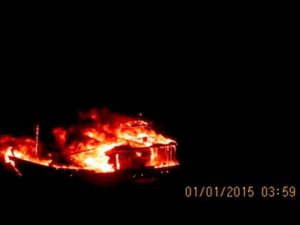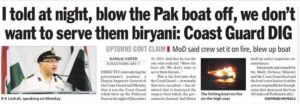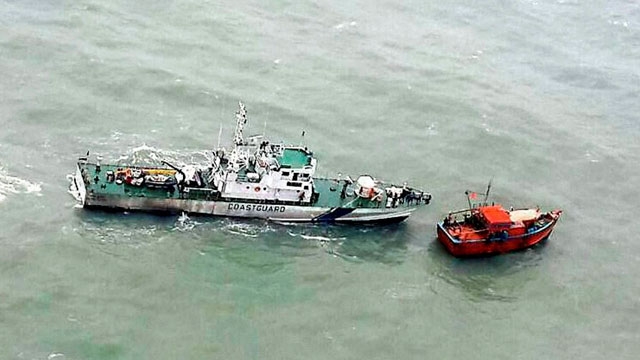Whenever I talk to civilians and indeed non-navy men, one of the biggest chasms that I have to cross is the minds-gap between us. It doesn’t easily sink in with people that seas are open in access, they have no visible boundaries, and hence there are gigantic problems of identification at sea especially when it comes to small fishing craft, the kind that ten terrorists from Karachi travelled in from Karachi to launch an attack on Mumbai on 26 Nov 2008 (26/11). With every inch of land owned by either governments or people and some having more than two competing claims, another thing that doesn’t easily soak in is that seas are largely unowned and anyone can be anywhere.
Most of the fishing in our waters is unregulated despite all efforts to bring in regulation post 26/11. Post 26/11 it was decided that all boats more than 20 m in length would be fitted with Automatic Identification System (AIS) and all boats would be registered and would have colour coding system to enable quick identification. Additionally, and all crews would have identification cards. Sounds great? Well, the closest analogy that comes to mind is that of a careful and safe Indian driver: he drives carefully and safely for about ten kilometres after witnessing an accident.
Somewhere in the vicinity of Jakhau (on the Northern side of Gulf of Kachchh in Gujarat), when the Indian minesweeper on which I was serving in 1976, used to come closer to fishing vessels and enquire about their identity, some of the vessels would first hoist a Pakistani flag and then when our identity would be revealed to them through our talk on the loud-hailer, they would quickly replace it with an Indian flag. The scenario continued without much variation for decades. After regular patrols started from both sides, many a fishermen (number in hundreds) on both sides of the IMBL (International Maritime Boundary Line) found themselves in prisons of the opposite side. Again, it is extremely difficult for non-navy people to realise that a line drawn on the map doesn’t actually manifest itself at sea and in the absence of familiar features that you find on the land (such as fence, wall, rock, pillars and sign-boards), it is difficult for the fishermen to even realise that they have crossed this invisible line of IMBL.
Early this month I was talking to research scholars of Punjab University studying to obtain Master of Philosophy degree; most of them being from Army background. When I told them that the Indian Navy wrongly got blamed for having allowed Kasab & co. to traverse the sea-route from Karachi to Mumbai which resulted in Mumbai attacks known as 26/11 attacks, most of them were up in arms against me. They said that it was an attack on the nation by foreign armed terrorists using the sea-route and hence the failure to detect and stop them should be pinned on the Navy. I brought out to them that in the like manner, the failure to prevent the attack on Indian parliament (the very seat of the Indian democracy), on 13th Dec 2001, perpetrated by terrorists of LeT and JeM, should have been pinned on the Indian Army since it was a land-based attack. Similarly, following the same reasoning, the failure to detect and prevent bicycle-bomb attacks in Jaipur, on 13th May 2008, should be pinned on the Mechanised Infantry, bicycle being a mechanised vehicle.
Firstly, a knee jerk reaction of the government post 26/11 made the Indian Navy the only leading navy in the world stuck with the responsibility of coastal security. Secondly, with both the target boats and the investigators constantly moving at sea, the only real identification would be whilst leaving and entering harbours. Post 26/11, in two joint exercises carried out in April and June 2009, by the Indian Navy, Coast Guard, Police and Customs, they were able to check the identities of only 300 and 1000 boats respectively. On land too, you don’t check the identities of vehicles by chasing them on highways, roads, streets, fields et al; you do so at choke points such as Toll Plazas, Barriers, Check-Points and the like.
What about Automatic Identification System transponders for the fishing boats so as to help provide quick identification at sea (in almost the same manner as IFF (Identification Friend or Foe) does it for aircraft? Well, two news items would be indicative of the progress made. First is a news item in the Times of India (ToI) on 12 Jul 2009 by Vishwa Mohan: ‘AIS transponders now made must for all fishing vessels’. And seven years later, here is a news item in the Indian Express on 09 Jun 2016: ‘Centre plans to install tracking devices on fishing vessels’; “With Home Minister Rajnath Singh set to chair a meeting on coastal security with CMs of nine coastal states and four Union Territories in Mumbai on June 16, government sources said modalities of implementing a crucial project to install automatic identification system transponders in all small fishing vessels could be finalised at the meeting.” In short, eight years after the Mumbai attacks, modalities to install AIS transponders were still to be finalised.
First of all, 100% installation of AIS on all craft is still to be implemented. Secondly, no technical means can provide warning of an intent in advance. One has to remember that one is looking for just one boat in thousands and lakhs that would have turned rogue from innocuous and innocent fishing boats earlier. To illustrate this point, lets look into MV Kuber, a vessel hijacked by Kasab and co. off Porbandar in international waters. Now, lets say this scenario was to replicate in future after 100 percent fitment of AIS. This innocuous and innocent fishing vessel having turned rogue would still give an AIS signal of a friendly and no-threat vessel.
Whilst on this subject, one curious fact that escaped most people’s attention was the news item that the master of Kuber, Amarsinh Solanki, was in a Pakistani prison just six months prior to his vessel having been hijacked by Kasab and co. Was it, therefore, just a coincidence that his vessel was the one that was hijacked at the appointed hour? Doesn’t that make identification of such a rogue craft and its intent even more confused? Isn’t that a pointer towards keeping an eye on the fishing community on the whole, an exercise beyond the scope of a maritime agency like the Indian Navy? Would Fishermen’s I-Cards and registration of all boats under the Merchant Shipping Act (MS Act) help? Yes, these would, if one remembers that such I-Cards and Registration cannot be checked at sea. Also, that most fishing boats use migrant labour who keeps changing frequently.
Take the incident of 31st Dec 2015 when a Pak boat carrying explosives blew itself up when challenged by a vessel of the Indian Coast Guard off the coast of Gujarat.

“The coast guard had received a specific intelligence alert on December 31 that a fishing boat from Keti Bunder near Karachi was planning some kind of an operation in the Arabian Sea.”
“Based on the input, a Dornier aircraft undertook a sea-air coordinated search and located the fishing boat. The ship patrolling in the area was diverted and intercepted the unlit boat around midnight of December 31,” the spokesperson said.
Imagine the effort required to intercept just one boat at sea.
“Parrikar had added that the Centre would ensure “99.99%” protection against 26/11-type incidents by timely detection. “How do you pull the needle out of the haystack? Zero tolerance to error is the most important in this project.””
The ironical point here is that even a preventive success story brought out the gigantic difficulties involved in identification and interception and that the answer lies in national will pertaining to “zero tolerance to error” is the only answer to pulling “the needle out of the haystack?”
We must also remember the fact that Coast Guard DIG B K Loshali was sacked for making the following remark on 16 Feb 2016 whilst addressing a gathering of Coast Guard officers and Larsen & Toubro officials during the launch of an interceptor boat (the remark was video taped and reported by the Indian Express: “Let me tell you. I hope you remember 31st December night. I was there at Gandhinagar and I told at night, blow the boat off. We don’t want to serve them biryani.”

Identification of Friend or Foe in Indian Maritime scenario and preventing repeat of 26/11 attacks are, therefore, mammoth tasks that require not just technical means but enormous coordination between many different agencies and, more than anything else, a national will to handle the aftermath of preventive efforts in international waters.

Fully endorse your views in this blog .Who will take corrective action ? Needs fortification at the highest level
True Sir. After our enemies have found that terrorism by sea route is a viable option, we need to have a pragmatic approach towards precluding it rather than merely keep planning.